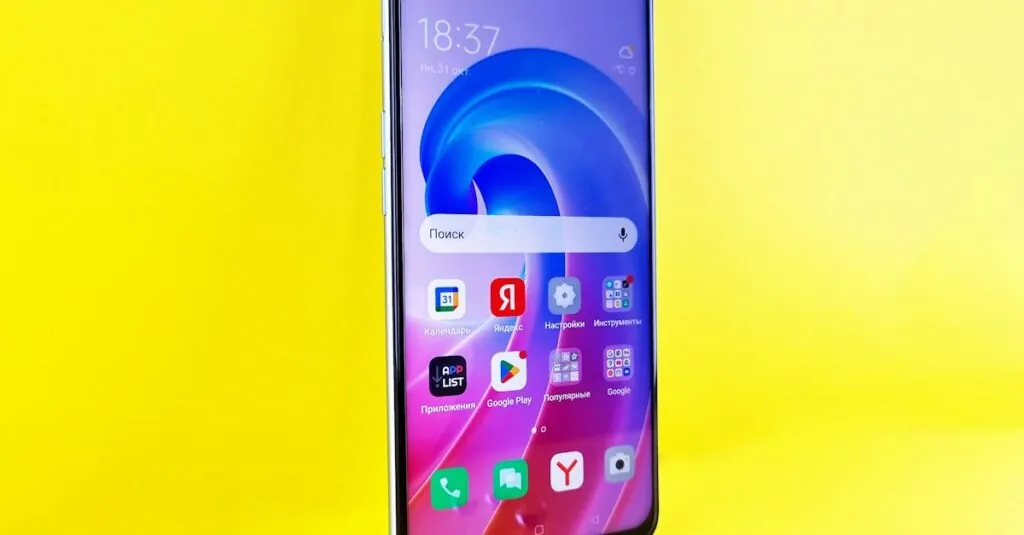In a world where smartphones reign supreme, the mobile operating system is the unsung hero behind the curtain. It’s the invisible force that powers everything from your morning alarm to that addictive game you just can’t quit. With countless options out there, choosing the right mobile OS can feel like picking a favorite child—impossible and fraught with potential disaster.
Table of Contents
ToggleOverview of Mobile Operating Systems
Mobile operating systems serve as the backbone of smartphones and tablets. Android and iOS dominate the market, each powering millions of devices globally. Android, developed by Google, allows manufacturers like Samsung and Huawei to customize the user experience. iOS, Apple’s operating system, provides a seamless experience across its devices, emphasizing security and performance.
Other mobile operating systems, such as Windows Phone and Tizen, exist but have significantly smaller market shares. Windows Phone discontinued support in 2017, illustrating the competitive nature of this sector. Tizen, mainly used in smart TVs and wearables, offers an alternative to Android and iOS but lacks widespread adoption.
Mobile OS features vary widely. User interface design plays a crucial role in user engagement. Android offers a customizable interface, enabling users to personalize their home screens with widgets and app icons. In contrast, iOS maintains a more uniform presentation, focusing on ease of use over customization.
App ecosystems also highlight differences in operating systems. The Google Play Store boasts millions of applications, catering to diverse user needs. Apple’s App Store features highly curated apps, emphasizing quality over quantity. Both platforms ensure application security through rigorous vetting processes.
Emerging mobile operating systems continue to make an impact. Companies are exploring alternatives, leveraging cloud-based technologies and artificial intelligence for enhanced user experiences. Mobile OS evolution responds to increasing demands for performance, security, and functionality in modern devices. As technology advances, the competitive landscape will likely shift, further defining the future of mobile operating systems.
Key Features of Mobile Operating Systems
Mobile operating systems feature distinct characteristics that enhance usability and security for users. Understanding these key elements is crucial in evaluating their impact and functionality.
User Interface and Experience
User interfaces vary significantly between mobile operating systems. Android provides customizable interfaces, allowing manufacturers to create unique designs. Users can modify their screens with widgets and app arrangements to suit personal preferences. In contrast, iOS maintains a consistent and uniform interface, prioritizing simplicity. Familiar icons and straightforward navigation facilitate ease of use across devices. App organization in iOS relies on pages rather than customizable layouts. Developers create both platforms’ applications with distinct design guidelines, ensuring a smooth user experience tailored to their respective ecosystems.
Security Measures
Security measures stand as a critical aspect of mobile operating systems. iOS incorporates stringent security protocols, including timely software updates and app review processes in the App Store. These practices help mitigate risks related to malware and unauthorized access. Android supports various security features, such as Google Play Protect, which scans apps for potential threats. Users benefit from options like biometric authentication and encrypted data storage on both systems. Companies increasingly prioritize user privacy and data protection, implementing advanced encryption techniques and enhanced security layers. Effective management of security measures reinforces trust in mobile operating systems, enabling users to navigate their devices confidently.
Popular Mobile Operating Systems
Several mobile operating systems exist today, each with unique strengths and user experiences. Android and iOS dominate the landscape, but other options also deserve attention.
Android
Android serves as the most widely used mobile operating system, with over 70% of the global market share. Developed by Google, it allows manufacturers like Samsung and Xiaomi to customize their devices. Users appreciate the versatility that includes widgets and varied home screen layouts. Frequent updates enhance performance and security, despite fragmentation challenges. The Google Play Store hosts more than 3 million apps, offering endless options for users.
iOS
iOS ranks as a strong competitor, powering Apple’s devices like the iPhone and iPad. This operating system prioritizes user experience, featuring a seamless and intuitive interface. With over 2 million apps available in the App Store, quality is often emphasized over quantity. Regular updates maintain a high level of security, protecting user data effectively. Many users value iOS for its integration with other Apple products, enhancing overall functionality.
Others (Windows, Blackberry, etc.)
Other mobile operating systems, such as Windows Phone and BlackBerry, have diminished in popularity. Windows Phone, discontinued in 2017, once aimed to provide a unified experience across devices. BlackBerry OS, known for secure messaging, has lost relevance amid rising competition. Tizen and KaiOS are emerging options, appealing to certain market segments. While these alternatives offer unique features, their small market shares limit widespread adoption.
Future Trends in Mobile Operating Systems
Emerging technologies are set to redefine mobile operating systems in the coming years. Increased focus on artificial intelligence (AI) integration enhances user personalization and improves overall functionality. For instance, AI-powered features will enable intuitive recommendations based on user habits and preferences.
5G technology is gaining traction, paving the way for enhanced connectivity and faster data transfer rates. With 5G, mobile OS developers will harness the potential of improved apps, streaming services, and real-time collaboration, creating seamless user experiences.
Augmented reality (AR) and virtual reality (VR) usage is expected to rise dramatically, influencing mobile OS development. As AR and VR applications become mainstream, mobile operating systems will need to support these technologies, allowing for innovative interactions and experiences.
Privacy measures are gaining importance, driving mobile OS improvements. Users demand more control over their data. Therefore, developers are prioritizing robust security features, including enhanced encryption and transparent data policies, ultimately building user trust.
Cross-platform functionality is becoming essential as users utilize multiple devices. Mobile OS developers will work towards creating a more unified experience across smartphones, tablets, and wearable devices. This shift will likely enhance accessibility and ease of use for diverse ecosystems.
The future of mobile operating systems revolves around embracing AI, 5G, AR/VR, privacy, and cross-platform functionality. The competitive landscape will adapt to these trends, fostering innovation and improved user experiences across all devices.
Mobile operating systems are vital to the way people interact with technology daily. As users navigate choices between Android and iOS, the decision often reflects personal preferences and needs. The landscape continues to evolve with emerging technologies like AI and 5G, promising enhanced experiences and functionalities.
Security and privacy remain top priorities as developers work to build trust and protect user data. With the rise of cross-platform functionality, the future of mobile operating systems looks bright, paving the way for innovative solutions that cater to diverse user demands. As these systems adapt, they’ll undoubtedly shape the way people connect and engage with their devices.










